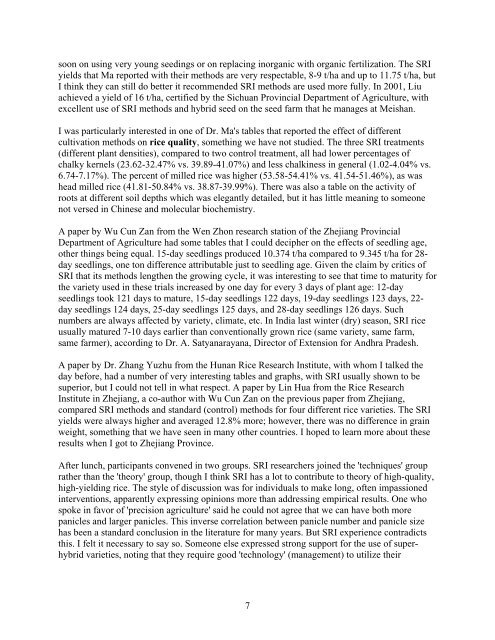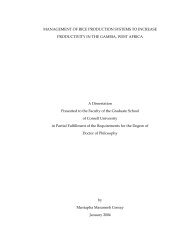Report from SRI China visit - The System of Rice Intensification ...
Report from SRI China visit - The System of Rice Intensification ...
Report from SRI China visit - The System of Rice Intensification ...
Create successful ePaper yourself
Turn your PDF publications into a flip-book with our unique Google optimized e-Paper software.
soon on using very young seedings or on replacing inorganic with organic fertilization. <strong>The</strong> <strong>SRI</strong><br />
yields that Ma reported with their methods are very respectable, 8-9 t/ha and up to 11.75 t/ha, but<br />
I think they can still do better it recommended <strong>SRI</strong> methods are used more fully. In 2001, Liu<br />
achieved a yield <strong>of</strong> 16 t/ha, certified by the Sichuan Provincial Department <strong>of</strong> Agriculture, with<br />
excellent use <strong>of</strong> <strong>SRI</strong> methods and hybrid seed on the seed farm that he manages at Meishan.<br />
I was particularly interested in one <strong>of</strong> Dr. Ma's tables that reported the effect <strong>of</strong> different<br />
cultivation methods on rice quality, something we have not studied. <strong>The</strong> three <strong>SRI</strong> treatments<br />
(different plant densities), compared to two control treatment, all had lower percentages <strong>of</strong><br />
chalky kernels (23.62-32.47% vs. 39.89-41.07%) and less chalkiness in general (1.02-4.04% vs.<br />
6.74-7.17%). <strong>The</strong> percent <strong>of</strong> milled rice was higher (53.58-54.41% vs. 41.54-51.46%), as was<br />
head milled rice (41.81-50.84% vs. 38.87-39.99%). <strong>The</strong>re was also a table on the activity <strong>of</strong><br />
roots at different soil depths which was elegantly detailed, but it has little meaning to someone<br />
not versed in Chinese and molecular biochemistry.<br />
A paper by Wu Cun Zan <strong>from</strong> the Wen Zhon research station <strong>of</strong> the Zhejiang Provincial<br />
Department <strong>of</strong> Agriculture had some tables that I could decipher on the effects <strong>of</strong> seedling age,<br />
other things being equal. 15-day seedlings produced 10.374 t/ha compared to 9.345 t/ha for 28day<br />
seedlings, one ton difference attributable just to seedling age. Given the claim by critics <strong>of</strong><br />
<strong>SRI</strong> that its methods lengthen the growing cycle, it was interesting to see that time to maturity for<br />
the variety used in these trials increased by one day for every 3 days <strong>of</strong> plant age: 12-day<br />
seedlings took 121 days to mature, 15-day seedlings 122 days, 19-day seedlings 123 days, 22day<br />
seedlings 124 days, 25-day seedlings 125 days, and 28-day seedlings 126 days. Such<br />
numbers are always affected by variety, climate, etc. In India last winter (dry) season, <strong>SRI</strong> rice<br />
usually matured 7-10 days earlier than conventionally grown rice (same variety, same farm,<br />
same farmer), according to Dr. A. Satyanarayana, Director <strong>of</strong> Extension for Andhra Pradesh.<br />
A paper by Dr. Zhang Yuzhu <strong>from</strong> the Hunan <strong>Rice</strong> Research Institute, with whom I talked the<br />
day before, had a number <strong>of</strong> very interesting tables and graphs, with <strong>SRI</strong> usually shown to be<br />
superior, but I could not tell in what respect. A paper by Lin Hua <strong>from</strong> the <strong>Rice</strong> Research<br />
Institute in Zhejiang, a co-author with Wu Cun Zan on the previous paper <strong>from</strong> Zhejiang,<br />
compared <strong>SRI</strong> methods and standard (control) methods for four different rice varieties. <strong>The</strong> <strong>SRI</strong><br />
yields were always higher and averaged 12.8% more; however, there was no difference in grain<br />
weight, something that we have seen in many other countries. I hoped to learn more about these<br />
results when I got to Zhejiang Province.<br />
After lunch, participants convened in two groups. <strong>SRI</strong> researchers joined the 'techniques' group<br />
rather than the 'theory' group, though I think <strong>SRI</strong> has a lot to contribute to theory <strong>of</strong> high-quality,<br />
high-yielding rice. <strong>The</strong> style <strong>of</strong> discussion was for individuals to make long, <strong>of</strong>ten impassioned<br />
interventions, apparently expressing opinions more than addressing empirical results. One who<br />
spoke in favor <strong>of</strong> 'precision agriculture' said he could not agree that we can have both more<br />
panicles and larger panicles. This inverse correlation between panicle number and panicle size<br />
has been a standard conclusion in the literature for many years. But <strong>SRI</strong> experience contradicts<br />
this. I felt it necessary to say so. Someone else expressed strong support for the use <strong>of</strong> superhybrid<br />
varieties, noting that they require good 'technology' (management) to utilize their<br />
7
















